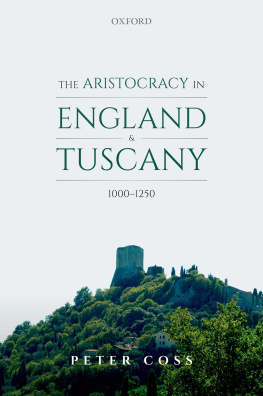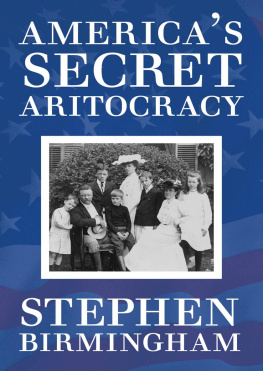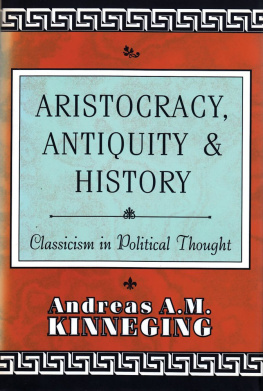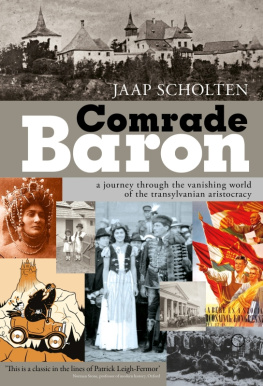The Aristocracy in England and Tuscany, 10001250

Great Clarendon Street, Oxford, OX2 6DP, United Kingdom
Oxford University Press is a department of the University of Oxford. It furthers the Universitys objective of excellence in research, scholarship, and education by publishing worldwide. Oxford is a registered trade mark of Oxford University Press in the UK and in certain other countries
Peter Coss 2020
The moral rights of the author have been asserted
First Edition published in 2020
Impression: 1
All rights reserved. No part of this publication may be reproduced, stored in a retrieval system, or transmitted, in any form or by any means, without the prior permission in writing of Oxford University Press, or as expressly permitted by law, by licence or under terms agreed with the appropriate reprographics rights organization. Enquiries concerning reproduction outside the scope of the above should be sent to the Rights Department, Oxford University Press, at the address above
You must not circulate this work in any other form and you must impose this same condition on any acquirer
Published in the United States of America by Oxford University Press
198 Madison Avenue, New York, NY 10016, United States of America
British Library Cataloguing in Publication Data
Data available
Library of Congress Control Number: 2019905195
ISBN 9780198846963
ebook ISBN 9780192586254
DOI: 10.1093/oso/9780198846963.001.0001
Printed and bound by
CPI Group (UK) Ltd, Croydon, CR0 4YY
Links to third party websites are provided by Oxford in good faith and for information only. Oxford disclaims any responsibility for the materials contained in any third party website referenced in this work.
To my niece, Batrice Ware
Acknowledgements
Much of the research and most of the writing of this book was undertaken following my retirement from Cardiff University, that is to say across the years 20142018. Its foundations were laid, however, on a Leverhulme Study Abroad Fellowship spent at Pisa during the academic year 2004/5. I am most grateful to the Trust for affording me this opportunity. I am most grateful, too, to Michele Luzzati and Giuseppe Petralia, successive heads of the Dipartimento della storia medievale, for supporting my application and for giving me access to their departmental library and facilities. Two of my academic friends at Pisa, Alessandra Veronese and Enrico Giaccherini, have been especially generous and hospitable to me and my wife during our many visits to Pisa over the years. I am very grateful to them and their families. I wish to express my thanks also to Maria Elena Cortese for generously sending me items of her work prior to publication, and to Tommaso Casini for so kindly giving me a copy of his doctoral thesis. I am grateful to Alma Poloni for reading my chapter on Pisa, and to Rosamond Faith for her critical reading of the chapters on Anglo-Saxon and Anglo-Norman England. Special thanks are due to Chris Wickham, the most generous of scholars, who not only gave freely of his time and unrivalled expertise in commenting on early drafts of many of the chapters but also strongly supported my project in a myriad ways from its inception to its completion. I wish to thank them all most heartily for the informative and enjoyable conversations I have had with them over the years. I would also like to thank the anonymous readers for Oxford University Press, most especially the Italian expert for his generosity and guidance.
I am most grateful to Ms Kirsty Harding, digital archaeological illustrator and graphic designer in the School of History, Archaeology and Religion, Cardiff University, for her excellent maps, and to my brother-in-law, Mr David Hill, of Stourbridge, for his equally excellent artwork and for supplying the cover photograph. I wish to thank Stephanie Ireland at Oxford University Press for her unstinting support and guidance, and all of her colleagues for the part they played in the production of this work. There would have been more errors and inconsistencies but for the careful eye of my copy editor, Sarah Barrett. I would also like to thank Sathiyavani Krishnamoorthy for her care and diligence in dealing with my proofs. Once again I wish to thank my wife, Angela Coss, my most severe critic, for her excellent copy-editing, her company in Italian libraries, and for much else besides. Needless to say any remaining errors, misinterpretations and infelicities are entirely my responsibility.
Contents
Cover photograph: Rocca di Tintinnano.
Maps
Genealogies
Figures
Anglo-Norman Studies
Anglo-Saxon England
Archivio di Stato di Firenze
Archivio storico italiano
Archivio di Stato di Pisa
Archivio di Stato di Siena
Bulletin of the Institute of Historical Research
Bollettino Storico Pisano
Codex Diplomaticus Amiatinus
Centro italiano di studi sullalto medioevo (Spoleto)
Domesday Book
Dizionario Biografico degli Italiani
Economic History Review
English Historical Review
Journal of Medieval History
Monumenta Germaniae Historica
Oxford Dictionary of National Biography
Past and Present
Rotuli Litterarum Clausarum
Regesta Regum Anglo-Normannorum
Document number assigned in P. H. Sawyer (ed.), Anglo-Saxon Charters: An Annotated List and Bibliography
Thirteenth-Century England
Transactions of the Royal Historical Society
Victoria History of the Counties of England
The reader needs to know the genesis of this book. Having studied the English gentry from a variety of perspectives and completed a book examining its origins, I felt that an important dimension was missing: a comparative one. I thus decided to compare the English gentry with the Tuscan nobility during the thirteenth and fourteenth centuries, and was fortunate enough to receive a Leverhulme Study Abroad Fellowship and spend the better part of an academic year in Pisa gathering material. Other commitments and a five-year stint as head of school at Cardiff University prevented me from continuing the project. When I did so, after retirement in 2013, it soon became clear to me, as it will to the readers of this book, that it was not feasible to begin this study in the thirteenth century. On the contrary, it was imperative to begin with an understanding of social evolution in Italy during the eleventh and twelfth centuries, a time of considerable change for the aristocracy. Hence the current work. This book is therefore a prequel to one which I still hope to write. In the meantime, it has an additional rationale of its own. It struck me forcibly that historians of medieval England, although aware of developments elsewhere, most particularly in France and to a lesser extent Germany, would benefit from bringing Mediterranean societies more into focus when studying England. The first part of this book is therefore devoted to an in-depth examination of the aristocracy in Tuscany as studied by Italian historians and others working within the Italian tradition. I decided to concentrate on a particular region to make the study more manageable, and Tuscany was chosen because of its accessibility. Its records, notwithstanding important gaps, are reasonably wide-ranging and its historiography rewarding, lively, and progressive. The second part of the book turns to England. My aim here is not a comparative study as such, despite my original intention, but rather to bring insights drawn from Tuscan history and Tuscan historiography into play in understanding the evolution of English society from around the year 1000 to around 1250. I will therefore conclude not with a comparison as such but with some general issues of interpretation.









